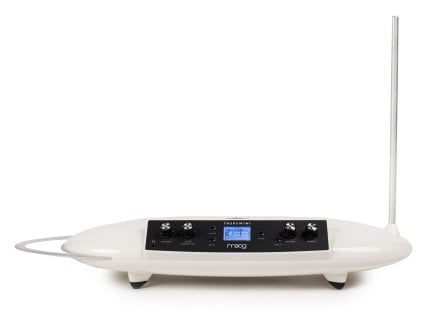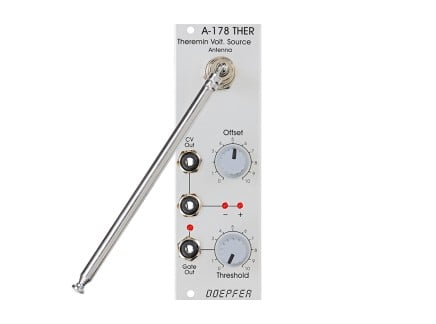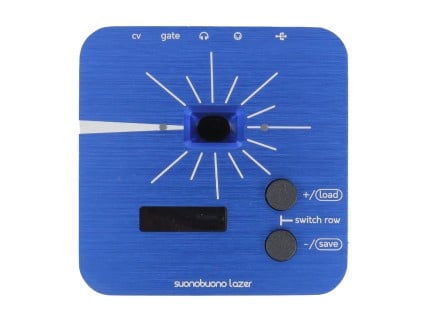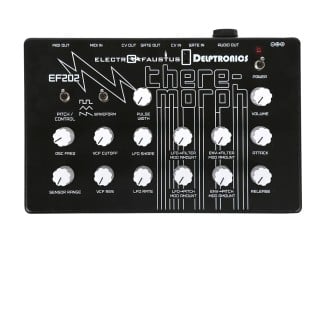I think we can all imagine it. A cheesy 1950s black-and-white horror movie. The alien invasion or sci-fi abomination approaches our young, attractive protagonists. The music is haunting, eerie, and features a strange electronic tone overtop it to emphasize the inhuman nature of the unfolding scene.
That bizarre electronic sound—smoothly sliding between pitches with a pronounced vibrato—is, in all likelihood, a theremin: one of the earliest electronic instruments.
What is a Theremin?
The theremin has had a long history between its inception in 1920s Soviet Russia and where we see the instrument today. Along the way, it has captivated many not only by the way it sounds, but the way it's played. Almost all instruments require the performer to directly touch them—but not the theremin. You may see a performer wildly gesture in the air and wonder, what are they doing?
The typical theremin has two antennae, one sticking vertically up, and the other, typically in a semi-circular loop, sits horizontally. The vertical antennae controls the pitch; the closer you are to it, the higher the pitch. The horizontal antennae controls the volume; the closer you are to it, the lower the volume. But...where does it come from?
A Brief History of the Theremin
The theremin's inventor, born Lev Sergeivitch Termen in 1896, showed an early interest in electronics. Electricity was revolutionizing the world, bringing the new possibilities of the 20th century to the far reaches of the globe. He studied both piano and cello but was not satisfied with the sound of acoustic instruments. However, there were no real widespread electronic instruments at the time.
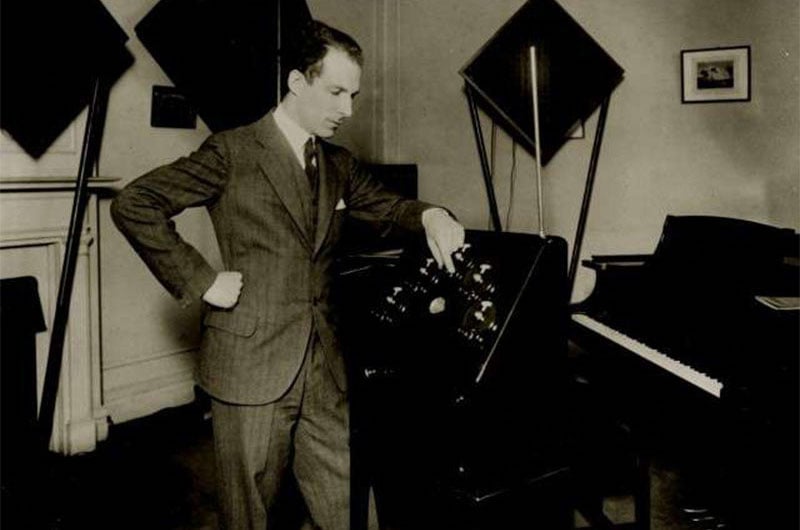
[Above: Lev Termen with his invention, the theremin.]
He fought in WWI and was an engineer during the Russian Revolution and Civil War on the side of the Bolsheviks. He started work at the Physico-Tehnical Institute in St. Petersburg, known then as Petrograd, and later Leningrad. He was put in charge of a department studying high-frequency oscillations. Although much of the country was hit with devastation, the newly-formed Soviet government placed emphasis on technological advancement.
One of his earliest inventions was a burglar alarm that would set off an audio alarm if someone passed through an electromagnetic field. In this alarm system, the capacitance of a person's body affects an electromagnetic field of radio waves, something essential in his later work. A body conducts electricity and acts as a sort of capacitor, storing and discharging an electrical charge; creating a system to detect or measure this capacitance can, hypothetically, indicate just how close a capacitive body is to the sensing system. This will be important later.
He set to work on a device to measure the density of gasses. He noticed the machine was accurate until his hand got too close to the device. Instead of just visually checking on a meter or gauge, he decided to put a sort of whistle to differential gas density by pitch. While I’m sure his colleagues were annoyed at first, within a short time, Termen was clunkily playing familiar tunes on the instrument.
So…let's get deeper into the details about how the theremin works.
The sound of a theremin is generated by heterodyning oscillators. You take two oscillators, one at a fixed frequency and another with a variable frequency. The variable frequency oscillator’s pitch is determined by the pitch antenna and the capacitance of the body as it moves through the electromagnetic field generated by the theremin. Both oscillators sit in the realm of radio waves, well above the range of human hearing. However, by mixing the two oscillators and deriving the difference in pitch between the two, you get a third signal within the range of human hearing, suitable for musical purposes. The mass of a person determines their capacitance. This means two people can have their hands the same distance from a theremin and get different frequencies and volume levels.
[Editor's note: if you have three analog AM radios tuned to very specific frequencies relative to one another, it's possible to approximate the behavior a theremin. Look up "three-radio theremin" for detailed instructions on how to do this.]
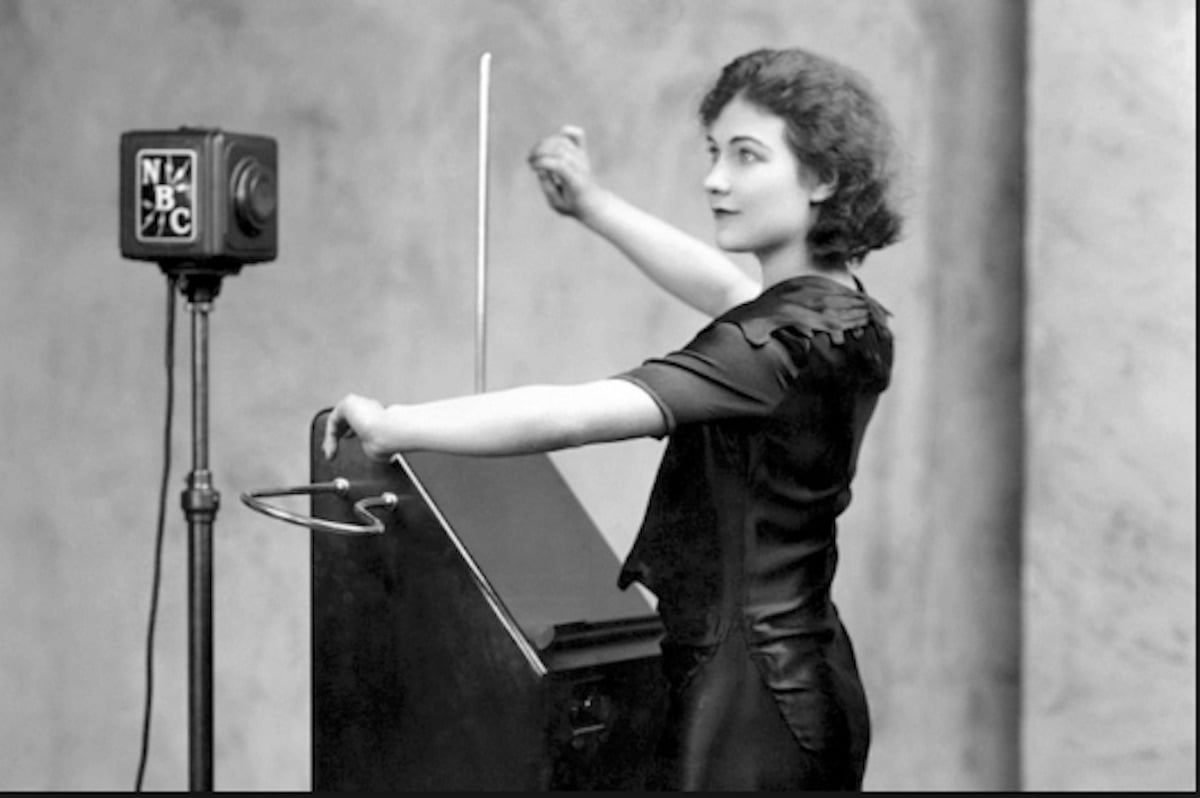
[Above: Alexandra Stepanoff playing a theremin in 1930.]
The first version of the theremin did not have a volume control loop, but rather a foot pedal to control its amplitude. Termen would go on to include the volume loop to create a totally touch-free instrument. While the pitch of the theremin goes up the closer you get to it, the volume is inversely controlled. Getting closer to it reduces the amplitude—or, as many thereminists think of it, moving your hand away from the antenna allows you to draw sound out of the instrument.
The theremin was originally called the Etherphone, named after a 19th-century idea that radio waves traveled through an all-encompassing substance called ether or aether. This medium conceptually facilitated the movement and transmission of electromagnetic waves, as their nature was not well known at the time. Einstein's special theory of relativity, introduced in 1905, did away with this earlier theory of the universe.
In the 1920s, the transistor as we know it today did not exist. As such, the original theremins relied heavily on vacuum tubes in their circuitry. Termen brought his early theremin to the 8th All-Union Electrical Conference, part of the State Commission for Electrification of Russia. One of the goals of the Bolsheviks was to proliferate electricity all across Russia to its outer provinces. Termen's performances both to the conference and later to the general public, caught the interest of Vladimir Lenin. Lenin commissioned 600 theremins to be built and showcased to the public as a way to spread Soviet propaganda of modern Russian innovation.
The first piece of music written for the theremin was in 1923 by Andrei Pashchenko, and other composers soon followed. Like many early inventors of electronic instruments, Termen thought his instrument would soon dominate all music, replacing all traditional instruments. As we know, this never happened, but his enthusiasm for marketing the theremin led to widespread exposure to new electronic music.
By 1927, Termen moved to the United States and had a patent for the instrument in 1928. RCA saw an opportunity, and began selling both DIY kits and prebuilt theremins in the 1930s. In 1938, Termen returned to Soviet Russia. There were many rumors about the nature of his disappearance from New York, with some people believing he was kidnapped. Termen has said it was a combination of financial and tax troubles, plus anxiety about the coming world war. After returning, he was arrested and put in a labor camp. His engineering skills were put to use for Russian intelligence agencies, including an early electronic surveillance device. He died in 1993 at the age of 97.
The best-known player of the theremin was Clara Rockmore. After immigrating from Lithuania in 1921, she enrolled in the Curtis Institute of Music. A child prodigy on violin, an injury derailed her career. She met Termen and quickly took up his instrument, practicing until she was as good at the theremin as she was with the violin. She was one of the first to truly develop an extensive, methodical playing technique for the theremin, keeping her body as still as possible, using perfected precise vibrato without noticeable pitch drift.
The theremin found use in movie soundtracks in the 1940s and '50s, famously including Miklos Rozsa's score for Hitchcock’s 1945 Spellbound. There were a few pop and rock songs that used it as well, but as more of a novelty sound effect compared to Rockmore’s virtuosic playing.
In 1949, the man whose name would become synonymous with synthesizers—Bob Moog—was 14, and discovered the theremin in an article in the magazine Electronics World. By the age of 19, he and his father were building and selling theremins. An article in Radio and Television News helped spread the word of his work with theremins, as he had made a new version of the instrument that was more stable, but still relatively easy to build.
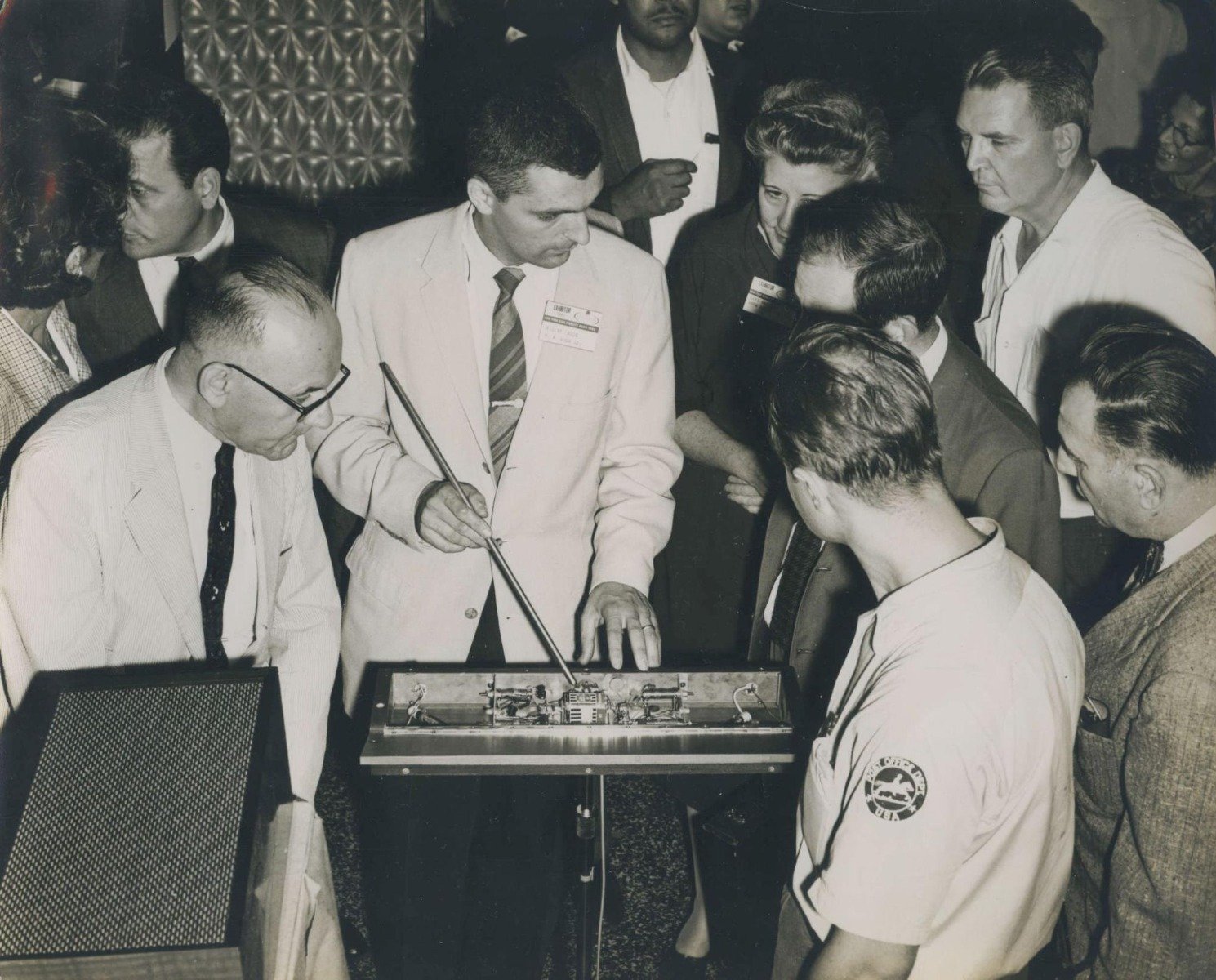
[Above: Bob Moog demonstrating his theremin designs in the 1960s.]
The R.A. Moog company was formed in upstate New York and sold theremin kits. In 1961, he began work on a new design for a theremin, replacing the vacuum tubes with transistors. This predated the Moog modular synthesizer by several years, and without the theremin, Bob Moog might never have designed that groundbreaking instrument. Termen was one of the biggest influences on Bob Moog, guiding the direction of his work. According to his daughter Michelle Moog-Koussa (executive director of the Bob Moog Foundation), Moog met Termen several times, which were some of the highlights of his life.
A Note on Playing the Theremin
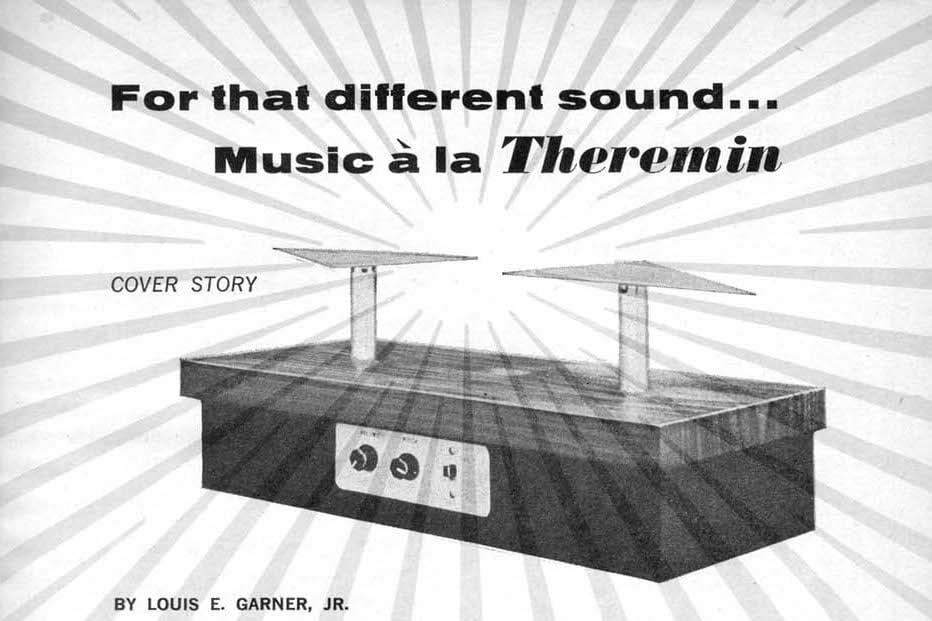
[Above: graphic from Louis E. Garner, Jr.'s article on the theremin in the November 1967 issue of Popular Electronics magazine.]
A little bit on playing the theremin from someone who doesn’t play it—you don’t have to be Clara Rockmore, Lydia Kavina, Pamelia Stickney, or Grégoire Blanc in order to enjoy playing the theremin. While it takes years of practice in order to play a melody precisely, you can have fun just messing around with a theremin. The pitch knob controls the electromagnetic field and how responsive the theremin is to movement. This allows you to tune the instrument to your range of movement. Tune the theremin’s lowest note in relation to your hand at a neutral setting, perhaps raised to your shoulder. Then, you can get the full range of pitch starting with your hand at its furthest away point and the highest frequency when your hand is all the way extended to the antenna.
With no movement of your hand next to the volume antenna, the pitch will always slide between notes. Moving your hands in conjunction, you can create volume ebbs and flows, breaking the portamento into individual notes.
Vibrato is a common part of theremin playing in order to create a wavering note that moves slightly up and down in pitch. To get a more pitch-stable vibrato, move your hands horizontally with minimal movement towards or away from the theremin. In fact, you should try to move the rest of your body as little as possible when playing the theremin, as your entire body has capacitance, not just your hands, and will impact the electromagnetic fields.
Modern Theremins and Theremin-Inspired Tools
Moog still continues to innovate in the realm of theremins. They look both to the past and future for inspiration, and still produce several distinct models of theremin.
The Etherwave Theremin captures the classic look of a theremin, but adds new features that bring it into the 21st century. You get full control over the volume and pitch range, plus waveform selection and brightness control to really dial in the character of the theremin. It includes both headphone and line-level outputs.
The most significant addition to the Etherwave Theremin is the CV and gate outputs on the rear of the unit. These allow you to control your modular or semi-modular synthesizers with both the pitch and volume antennae, plus a gate output. The Etherwave outputs a gate signal when the Volume control goes above 0V and when the pitch is above 0Hz. This classic theremin brings Bob Moog’s early experiments in theremin technology to modern synthesis—for use as a full instrument, or as a source of performative control.
While the Etherwave looks more to the past, the Theremini looks intensely at the future. Perhaps the most significant addition to the design is the adjustable pitch quantization. Select a scale and root note from the buttons; the Theremini will always stick to that scale. This takes the most difficult part of playing the theremin, playing pitches accurately, and does away with it. The pitch correction includes a pitch correction knob to control the amount of quantization, allowing freedom to add smooth gliding and subtle vibrato to your playing.
Not only that, but a wavetable engine adds timbral flexibility not found on older theremins. The 32 preset slots include sounds from the Animoog sound engine. A built-in stereo ping-pong delay adds space and movement to your playing. I/O includes 1/4" stereo output, headphone out, 1/4" CV out, DIN MIDI in and out, plus USB connectivity. Connecting to your computer via USB grants access to preset control and a host of new sounds that expand the onboard synthesis engine.
The Moog Claravox takes its name from one of the virtuosos of the theremin, Clara Rockmore. The design is elegant and classic, harkening back to the mid-twentieth century with its wooden enclosure and cream front panel.
It combines the best parts of vintage and modern takes on the theremin. The performance switch selects between traditional and modern settings. The traditional mode works much like the Etherwave, giving classic theremin sound and behavior. The modern mode adds DSP quantization and wavetable synthesis for a huge and dynamic sound. An onboard BBD delay gives the classic warm delay that takes your playing and sound design to the next level.
Claravox includes both DIN MIDI in and out, as well as USB connectivity for both MIDI and editing the parameters of the Claravox. Both the volume and pitch antennae send CV signals out for modular modulation, and you can control the behavior with both a momentary mute switch and expression pedal/CV input, which by default controls the filter frequency.
Of course, there are plenty of other takes on the theremin concept out there, as well.
The Doepfer A-178 puts the theremin’s trademark antenna in your modular synthesizer. While you’ll need two to get an authentic theremin behavior, one is more than enough to get gestural control over your Eurorack synthesizer. It includes a BNC connector for the antenna, two CV outputs with adjustable offset for the zero position, and a gate output with control over the threshold. The range is approximately 30–40cm (11–15"), so quite a bit smaller than a traditional theremin. If using two together, make sure they’re more than 40cm/15" apart, or they may interfere with one another.
While not a theremin in the traditional sense, the Theremoph EF202 from Delptronics and Electro-Faustus allows for theremin-like control over selectable parameters. Instead of an electromagnetic field, an optical theremin uses a light-dependent resistor to create modulation that responds to light levels. In practice, waving your hands or a light over the synth produces sounds reminiscent of a theremin with a smooth gliding between pitches. The EF202 includes a digitally controlled oscillator with analog waveforms, transistor ladder lowpass filter, LFO, A/D envelope, DIN MIDI, and CV in and out.
Into the Ether
The theremin has captured audiences and users alike in its over 100-year history. This instrument laid the groundwork for hundreds of electronic instruments that came after. We might not have had a Moog modular without Lev Termen’s spark of curiosity and experimentation.
While it’s a difficult instrument to master, everyone can have a lot of fun doing creepy sound effects and swells of electronic portamento.


